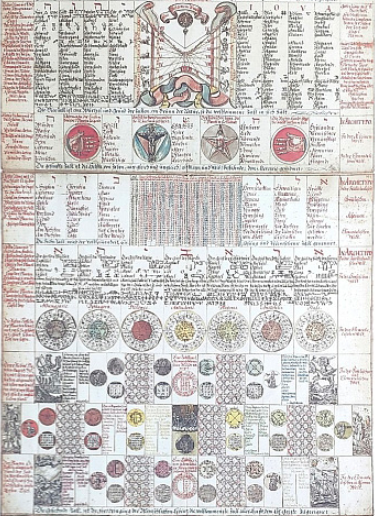Magical Calendar
The Calendarium Naturale Magicum Perpetuum, commonly called the Magical Calendar is a late Renaissance (c.1619-1620) grimoire and esoteric print of calendar engravings.
Author
The "author" in the 1619 (or 1620) Frankfurt print is given as Johann Baptist Grossschedel von Aicha (Frankfurt 1620), and attributes some of the engravings to Tycho Brahe. The original engraver is given as Theodor de Bry (Flemish-born German engraver, 1528–98) as originally published in 1582. The 1620 engraver used by Grossschedel may be Matthäus Merian the Elder (Swiss engraver, 1593–1650). The work predated, and influenced, the Rosicrucian furor.
Content
It is in three sheets, measuring more than four feet long and about two feet wide, and includes an early example of a Pentagrammaton, an allegorical form of the Hebrew name of Jesus, constructed from the original form of Jesus to be "Yeshua."
The calendar contains sigils and magic squares that may be used for evoking specific angels and demons during various days of the year. It gives lists of angels that rule over the days of the week as well as the Archangels of the Zodiac who rule over the 12 signs of the zodiac.
The first edition of the calendar is written in Latin, with a second edition in German. Both editions contain Hebrew characters, in an attempt to relate the astrological information to the principles of the Kabbalah, although the author or copyist's unfamiliarity with Hebrew caused some errors to creep into the German edition of the text.
